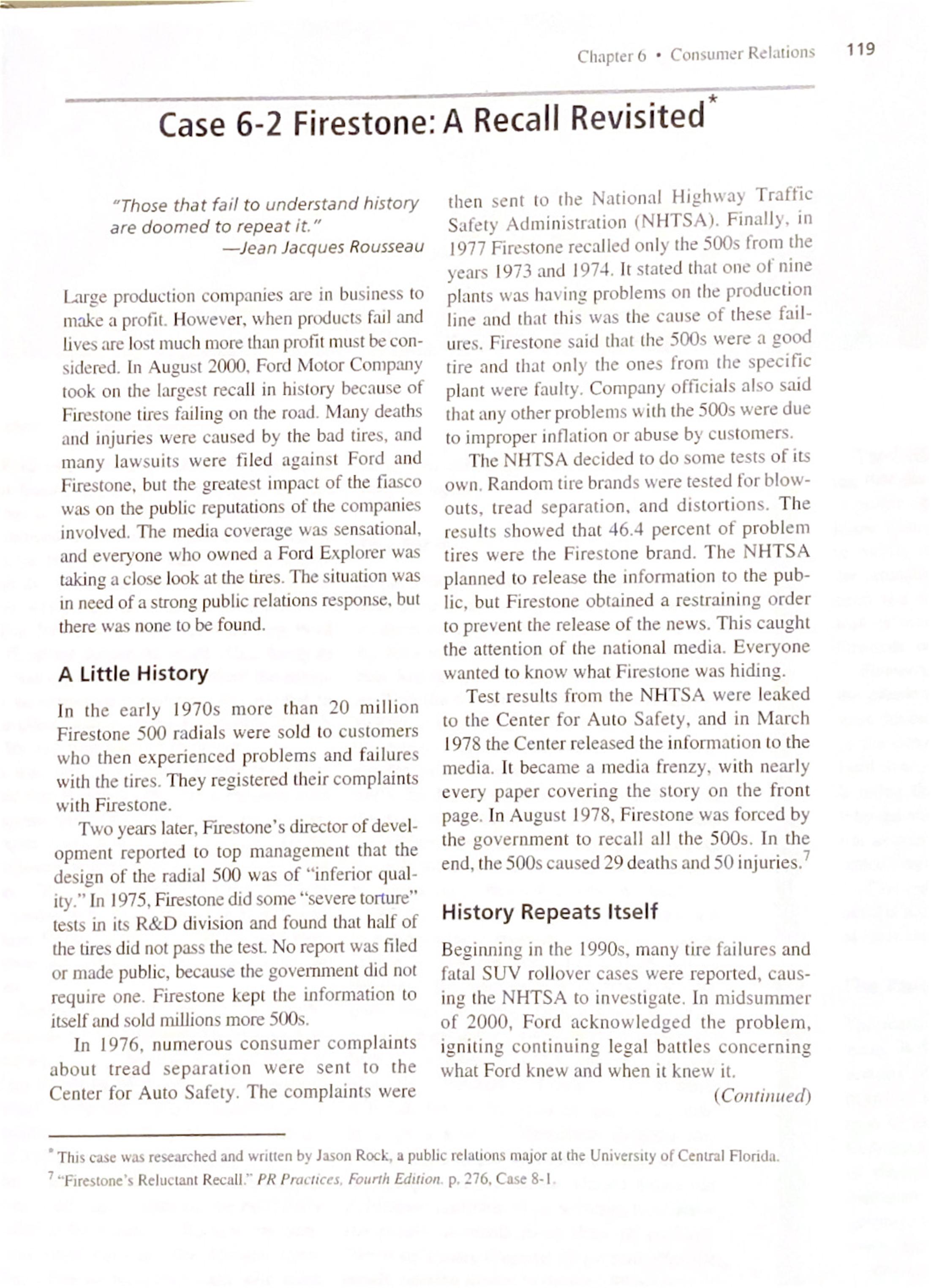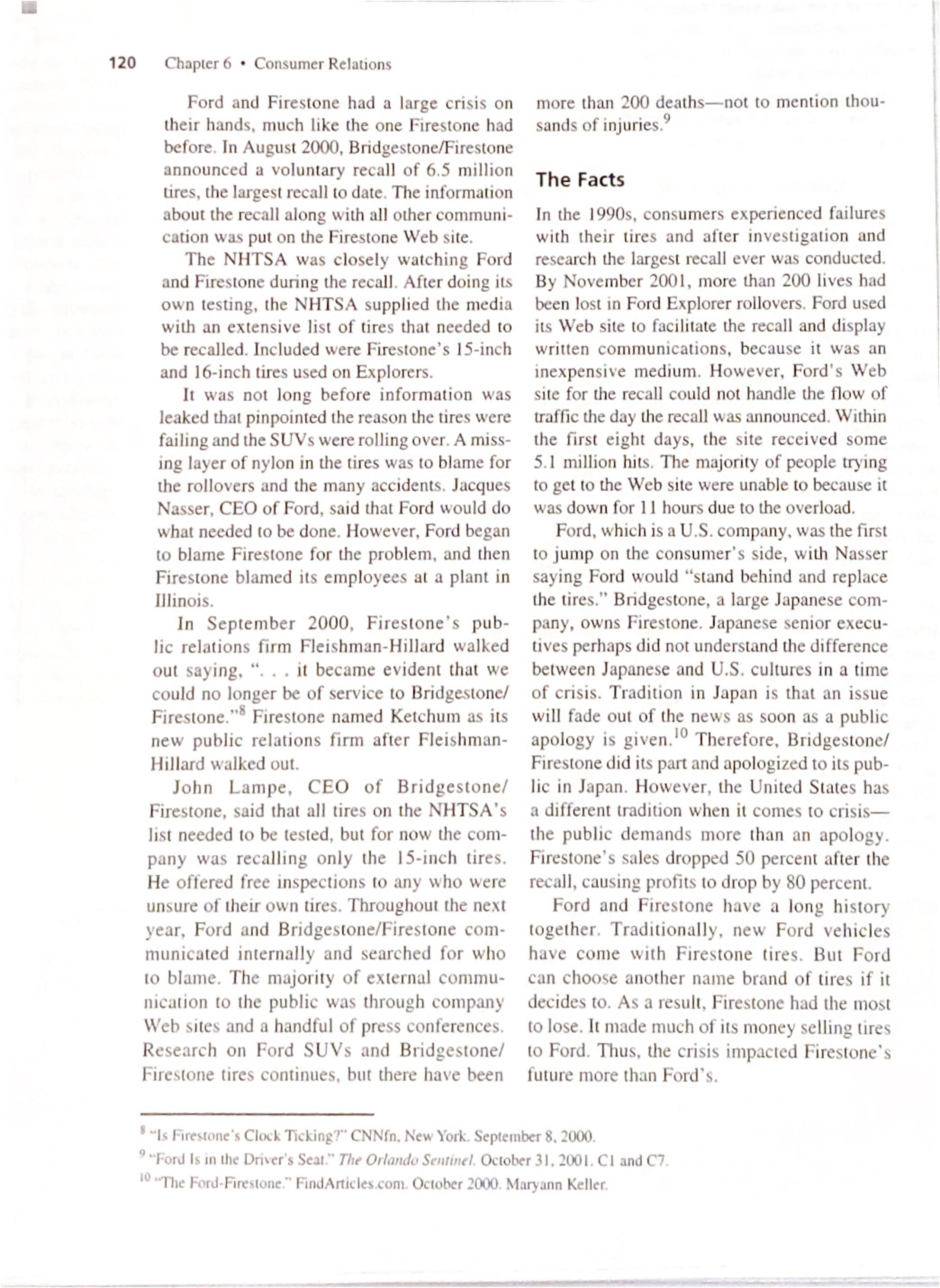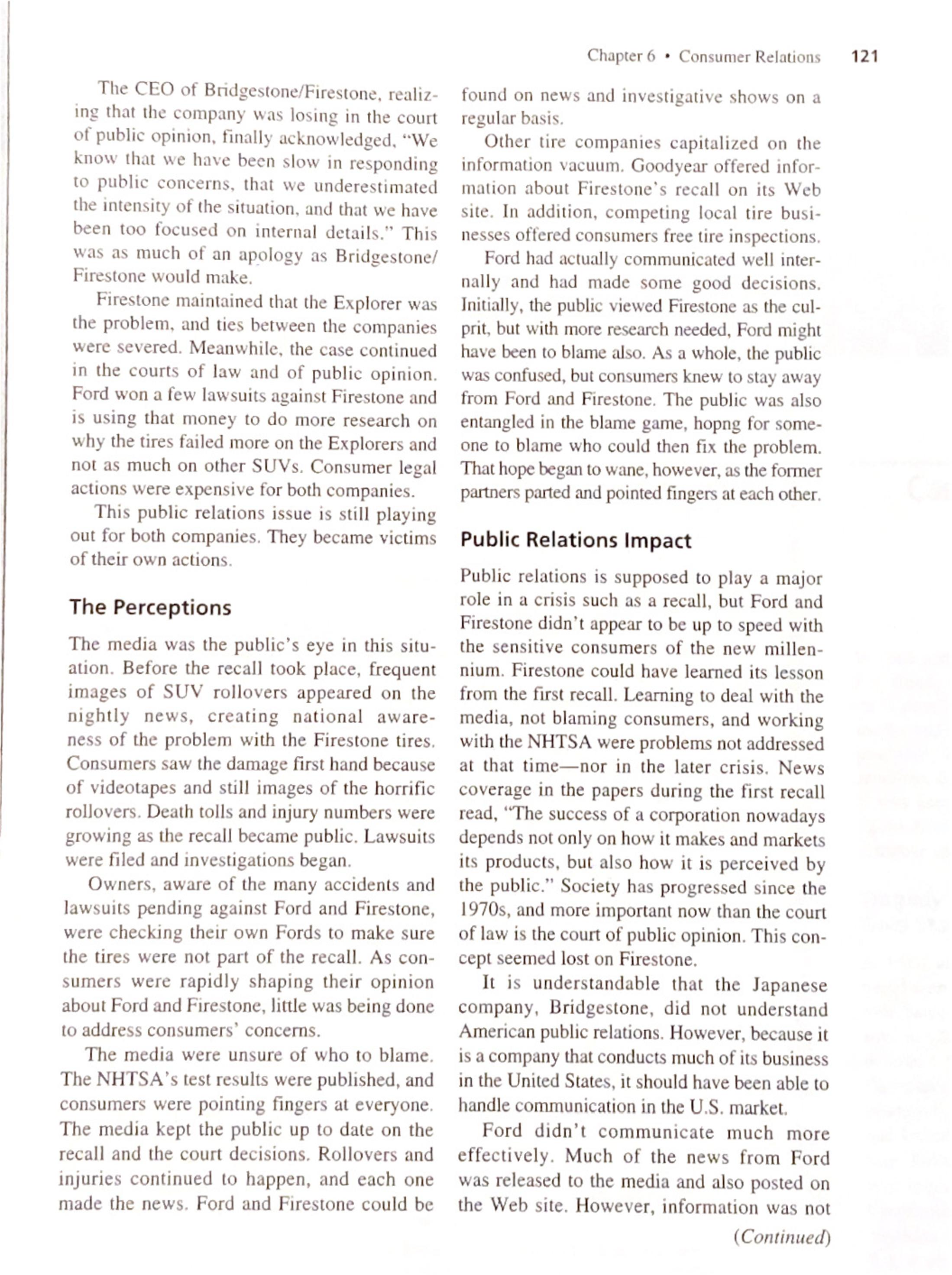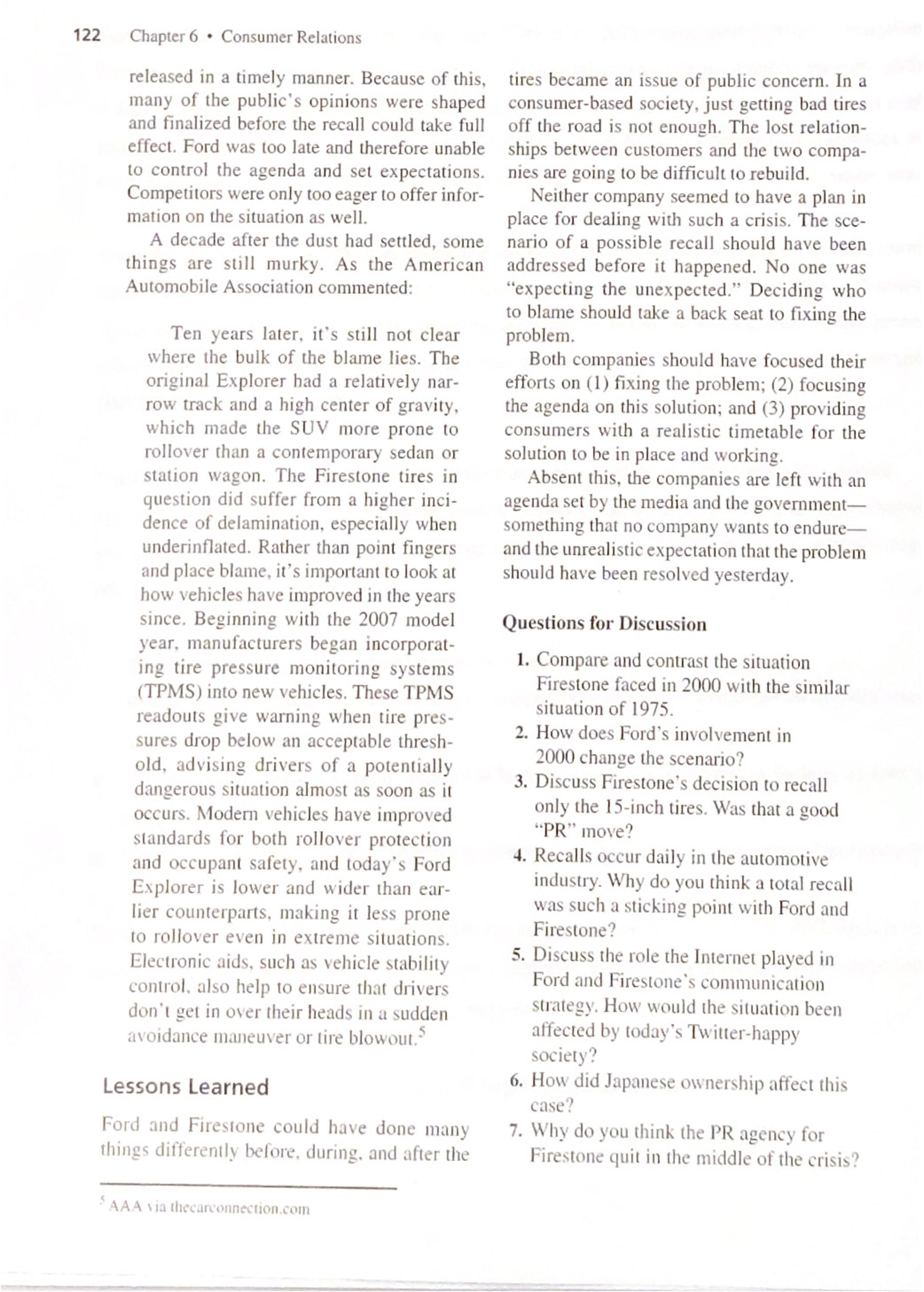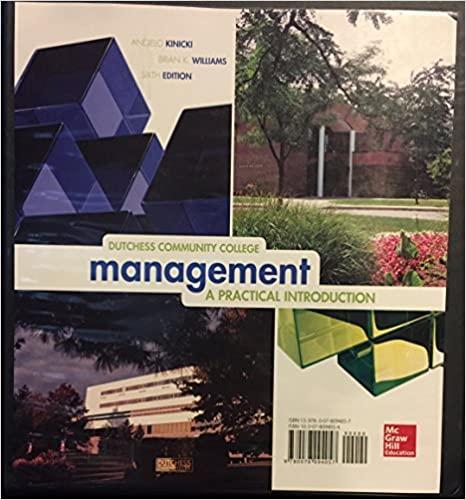Answer the following questions regarding the case "Firestone: A Recall Revisited":
- Explain the role the Internet played in Ford and Firestone's communication strategy.
- How would the situation been affected by today's Twitter-happy society?
- How did Japanese ownership affect this case?
- Why the PR agency for Firestone quit in the middle of the crisis?
Note: The case from where the asked questions will be answered is as follows:
Cliaptero - Consumer Relations ________________________.______.;--- Case 6-2 Firestone: A Recall Revisited \"Those that fail to understand history are doomed to repeat it. \" -Jean Jacques Rousseau Large production companies are in business to make a prot. However. when products fail and lives are lost much more than prot must be con- sidered. In August 2000. Ford Motor Company took on the largest recall in history because of Firestone tires failing on the road. Many deaths and injuries were caused by the bad tires. and many lawsuits were led against Ford and Firestone. but the greatest impact of the asco was on the public reputations of the companies involved. The media coverage was sensational, and everyone who owned a Ford Explorer was taking a close look at the tires. The situation was in need of a strong public relations response. but there was none to be found. A Little History In the early 19705 more than 20 million Firestone 500 radials were sold to customers who then experienced problems and failures with the tires. They registered their complaints with Firestone. Two years later. Fuestone's director of devel- opment reported to top management that the design of the radial 500 was of \"inferior qual- ity." In 1975, Firestone did some \"severe torture\" tests in its R&D division and found that half of the tires did not pass the test. No report was led or made public, because the government did not require one. Firestone kept the information to itself and sold millions more 5005. In 1976. numerous consumer complaints about tread separation were sent to the Center for Auto Safety. The complaints were then sent to the National Highway Trafc Safety Administration (NHTSA). Finally. in 1977 Firestone recalled only the 5005 from the yeais I973 and 1974. It stated that one of nine plants was having problems on the production line and that this was the cause of these fail- ures. Firestone said that the 5003 were a good tire and that only the ones from the specic plant were faulty. Company ofcials also said that any other problems with the 5005 were due to improper ination or abuse by customers. The N HTSA decided to do some tests of its own. Random tire brands were tested for blow- outs, tread separation. and distortions. The results showed that 46.4 percent of problem tires were the Firestone brand. The NHTSA planned to release the information to the pub- lic, but Firestone obtained a restraining order to prevent the release of the news. This caught the attention of the national media. Everyone wanted to know what Firestone was hiding. Test results from the NHTSA were leaked to the Center for Auto Safety. and in March 1978 the Center released the information to the media. It became a media frenzy, with nearly every paper covering the story on the front page. In August 1978. Firestone was forced by the government to recall all the 5005. In the end, the 5005 caused 29 deaths and 50 injuries.7 History Repeats Itself Beginning in the [9905, many tire failures and fatal SUV rollover cases were reported, caus- ing the NHTSA to investigate. In midsummer of 2000, Ford acknowledged the problem. igniting continuing legal battles concerning what Ford knew and when it knew it. (Continued) ' This case was researched and written by Jason Rock. a public relations major at the University of Central Florida. 7 \"Firestone's Relucrant Recall." PR Practices. Fourth Edition. p. 276. Case 8-]. 119 120 Chapter 6 . Consumer Relations Ford and Firestone had a large crisis on more than 200 deaths-not to mention thou- their hands, much like the one Firestone had sands of injuries.' before. In August 2000, Bridgestone/Firestone announced a voluntary recall of 6.5 million The Facts tires, the largest recall to date. The information about the recall along with all other communi- In the 1990s, consumers experienced failures cation was put on the Firestone Web site. with their tires and after investigation and The NHTSA was closely watching Ford research the largest recall ever was conducted. and Firestone during the recall. After doing its By November 2001, more than 200 lives had own testing, the NHTSA supplied the media been lost in Ford Explorer rollovers. Ford used with an extensive list of tires that needed to its Web site to facilitate the recall and display be recalled. Included were Firestone's 15-inch written communications, because it was an and 16-inch tires used on Explorers. inexpensive medium. However, Ford's Web It was not long before information was site for the recall could not handle the flow of leaked that pinpointed the reason the tires were traffic the day the recall was announced. Within failing and the SUVs were rolling over. A miss- the first eight days, the site received some ing layer of nylon in the tires was to blame for 5.1 million hits. The majority of people trying the rollovers and the many accidents. Jacques to get to the Web site were unable to because it Nasser, CEO of Ford, said that Ford would do was down for 1 1 hours due to the overload. what needed to be done. However, Ford began Ford, which is a U.S. company, was the first to blame Firestone for the problem, and then to jump on the consumer's side, with Nasser Firestone blamed its employees at a plant in saying Ford would "stand behind and replace Illinois. the tires." Bridgestone, a large Japanese com- In September 2000, Firestone's pub- pany, owns Firestone. Japanese senior execu- lic relations firm Fleishman-Hillard walked tives perhaps did not understand the difference out saying, ". . . it became evident that we between Japanese and U.S. cultures in a time could no longer be of service to Bridgestone/ of crisis. Tradition in Japan is that an issue Firestone." Firestone named Ketchum as its will fade out of the news as soon as a public new public relations firm after Fleishman- apology is given. Therefore, Bridgestone/ Hillard walked out. Firestone did its part and apologized to its pub- John Lampe, CEO of Bridgestone/ lic in Japan. However, the United States has Firestone, said that all tires on the NHTSA's a different tradition when it comes to crisis- list needed to be tested, but for now the com- the public demands more than an apology. pany was recalling only the 15-inch tires. Firestone's sales dropped 50 percent after the He offered free inspections to any who were recall, causing profits to drop by 80 percent. unsure of their own tires. Throughout the next Ford and Firestone have a long history year, Ford and Bridgestone/Firestone com- together. Traditionally, new Ford vehicles municated internally and searched for who have come with Firestone tires. But Ford to blame. The majority of external commu- can choose another name brand of tires if it nication to the public was through company decides to. As a result, Firestone had the most Web sites and a handful of press conferences. to lose. It made much of its money selling tires Research on Ford SUVs and Bridgestone/ to Ford. Thus, the crisis impacted Firestone's Firestone tires continues, but there have been future more than Ford's. " "Is Firestone's Clock Ticking?" CNNfn. New York. September 8, 2000. 9 "Ford Is in the Driver's Seat." The Orlando Sentinel. October 31, 2001. CI and C7. 10 "The Ford-Firestone." FindArticles.com. October 2000. Maryann Keller.The CEO of Bridgestone/Firestone. realiz- ing that the company was losing in the court of public opinion. nally acknowledged. \"We know that we have been slow in responding to public concerns. that we underestimated the intensity of the situation. and that we have been too focused on internal details." This was as much of an apology as Bridgestone/ Firestone would make. Firestone maintained that the Explorer was the problem. and ties between the companies were severed. Meanwhile. the case continued in the courts of law and of public opinion. Ford won a few lawsuits against Firestone and is using that money to do more research on why the tires failed more on the Explorers and not as much on other SUVs. Consumer legal actions were expensive for both companies. This public relations issue is still playing out for both companies. They became victims of their own actions. The Perceptions The media was the public's eye in this situ- ation. Before the recall took place, frequent images of SUV rollovers appeared on the nightly news, creating national aware- ness of the problem with the Firestone tires. Consumers saw the damage rst hand because of videotapes and still images of the horric rollovers. Death tolls and injury numbers were growing as the recall became public. Lawsuits were led and investigations began. Owners. aware of the many accidents and lawsuits pending against Ford and Firestone, were checking their own Fords to make sure the tires were not part of the recall. As con- sumers were rapidly shaping their opinion about Ford and Firestone, little was being done to address consumers' concerns. The media were unsure of who to blame. The NHTSA's test results were published. and consumers were pointing ngers at everyone. The media kept the public up to date on the recall and the court decisions. Rollovers and injuries continued to happen, and each one made the news. Ford and Firestone could be Chapter6 0 Consumer Relations found on news and investigative shows on a regular basis. Other tire companies capitalized on the information vacuum. Goodyear offered infor- mation about Firestone's recall on its Web site. In addition. competing local tire busi- nesses offered consumers free tire inspections. Ford had actually communicated well inter- nally and had made some good decisions. Initially. the public viewed Firestone as the cul- prit. but with more research needed. Ford might have been to blame also. As a whole. the public was confused. but consumers knew to stay away from Ford and Firestone. The public was also entangled in the blame game. hopng for some- one to blame who could then x the problem. That hope began to wane. however, as the former partners parted and pointed ngers at each other. Public Relations Impact Public relations is supposed to play a major role in a crisis such as a recall. but Ford and Firestone didn't appear to be up to speed with the sensitive consumers of the new millen- nium. Firestone could have learned its lesson from the first recall. Learning to deal with the media, not blaming consumers. and working with the NH'I' SA were problems not addressed at that timenor in the later crisis. News coverage in the papers during the rst recall read. \"The success of a corporation nowadays depends not only on how it makes and markets its products. but also how it is perceived by the public." Society has progressed since the 19705, and more important now than the court of law is the court of public opinion. This con- cept seemed lost on Firestone. It is understandable that the Japanese company. Bridgestone. did not understand American public relations. However, because it is a company that conducts much of its business in the United States. it should have been able to handle communication in the US. market. Ford didn't communicate much more effectively. Much of the news from Ford was released to the media and also posted on the Web site. However. information was not (Continued) 121 .w..- 122 Chapter 6 0 Consumer Relations released in a timely manner. Because of this. many of the public's opinions were shaped and nalized before the recall could take full effect. Ford was too late and therefore unable to control the agenda and set expectations. Competitors were only too eager to offer infor mation on the situation as well. A decade after the dust had settled. some things are still murky. As the American Automobile Association commented: Ten years later. it's still not clear where the bulk of the blame lies. The original Explorer had a relatively nar- row track and a high center of gravity, which made the SUV more prone to rollover than a contemporary sedan or station wagon. The Firestone tires in question did suffer from a higher inci- dence of delamination. especially when underinflated. Rather than point ngers and place blame. it's important to look at how vehicles have improved in the years since. Beginning with the 2007 model year. manufacturers began incorporat- ing tire pressure monitoring systems (TPMS) into new vehicles. These TPMS readouts give warning when tire pres- sures drop below an acceptable thresh- old. advising drivers of a potentially dangerous situation almost as soon as it occurs. Modem vehicles have improved standards for both rollover protection and occupant safety. and today's Ford Explorer is lower and wider than ear- lier counterparts. making it less prone to rollover even in extreme situations. Electronic aids. such as vehicle stability control. also help to ensure that drivers don't get in over their heads in a sudden avoidance tmuteuver or tire blowout.5 Lessons Learned Ford and Firestone could have done many things differently before. during. and after the ( ' AAA \\ta literati-tinnedtoncutn tires became an issue of public concern. In a consumer-based society, just getting bad tires off the road is not enough. The lost relation- ships between customers and the two compa- nies are going to be difcult to rebuild. Neither company seemed to have a plan in place for dealing with such a crisis. The sce~ nario of a possible recall should have been addressed before it happened. No one was "expecting the unexpected." Deciding who to blame should take a back seat to xing the problem. Both companies should have focused their efforts on (1) xing the problem; (2) focusing the agenda on this solution; and (3) providing consumers with a realistic timetable for the solution to be in place and working. Absent this, the companies are left with an agenda set by the media and the govemment something that no company wants to endure and the unrealistic expectation that the problem should have been resolved yesterday. Questions for Discussion 1. Compare and contrast the situation Firestone faced in 2000 with the similar situation of 1975. 2. How does Ford's involvement in 2000 change the scenario? 3. Discuss Firestone's decision to recall only the 15-inch tires. Was that a good \"PR" move? 4. Recalls occur daily in the automotive industry. Why do you think a total recall was such a sticking point with Ford and Firestone? 5. Discuss the role the Internet played in Ford and Firestone's communication strategy. How would the situation been affected by today's Twitter-happy society? 6. How did Japanese ownership affect this case? 7. Why do you think the PR agency for Firestone quit in the middle of the crisis
